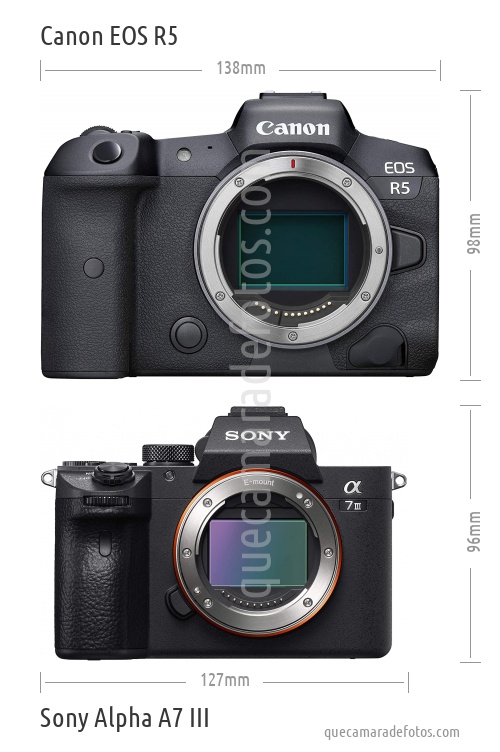
Images seem clearer without a low-pass filter, although there is a danger of moiré in certain settings. You may determine the sensor’s pixel density by looking at how many million pixels are packed into a square centimeter of the sensor. You can measure pixel pitch by looking at the distance between each pixel and the pixel in front of it. Are the Canon 90D and Sony A7 among the best cameras in their class based on their spec sheets? To find out whether these two cameras are among the best, check out the most recent Best DSLR Camera and Best Mirrorless Interchangeable Lens Camera lists. Canon’s 90D is a newer model that is part of the company’s current product range.
When it comes to cameras, Sony’s smaller, more lightweight a7 III will delight those who want a compact system for everyday use and travel, but yet have the power and versatility of full frame sensors… With a 1.8x crop ratio, the Canon camera’s sensor essentially shrinks a 30mm lens to a 54mm focal length, making it unusable for landscape photography. Although the electronic replica of the view is underwhelming as with other mirrorless cameras, using the Sony a7 III up close and taking in the sight isn’t likely to inspire awe, to be honest. After using the Sony for some time, you’d agree that the viewfinder was practical and acceptable.

Compared to models in the more consumer-friendly Rebel series, the fit and finish, splash and dust protection, and shooting buffer are all more durable. This Sony vs Canon comparison didn’t provide the best results for the Canon EOS R, but it is still a competent camera for the majority of users. For professionals, Sony’s a7 iii is a superior choice, but if you’re not, Canon’s attention to detail in the LCD screen and viewfinder may convince you. Another plus is that the camera’s full-frame capture is used to downsample, resulting in a super-crisp 4K video quality that is more than enough for professional usage. The Canon EOS R is capable of producing acceptable but not amazing video for the web if you can live with the 1.8x crop factor and mediocre rolling-shutter outcomes. In addition to the price of the body, it’s essential to consider the cost of other accessories, such as lenses, before making the investment in a new full frame camera.

Sony Alpha A7 III vs Canon Sony Alpha A7 III vs Canon EOS 90D Eos 90d
Q button, which slides down and over compared to its prior location, replaces the 80D’s Play button, which moves down and over a tiny bit. The focus control has a textured feel and there are no other buttons in the vicinity of Q, making them simple to locate by touch alone. The Sony a7 series mirrorless may be used with Canon lenses using an adaptor. When utilizing these adapters and lenses, autofocus accuracy degrades significantly, although manual focusing performs much better. Although Sony is often regarded as the best mirrorless full-frame camera on the market, Canon has a more extensive variety of lenses.
Autofocus

The A7, on the other hand, has been phased out of production (but can be found pre-owned on ebay). SDXC cards are used by the 90D, whereas SDXC or Memory Stick PRO Duo cards are used by the A7. Ultra High Speed data transmission of up to 312 MB/s is supported by the 90D; however, UHS-I cards (up to 104 MB/s) are supported by the A7. Both cameras’ physical specifications are included in an adjacent table, along with a larger range of choices. A wide range of camera combinations are available via the CAM-parator app, which may be accessed through your mobile device’s web browser.
Factors Affecting the Crop

RAW files reveal that both systems are capable of capturing high-quality photographs that can be readily upgraded in post-processing to extremely high standards. Instead of oversampling 6K recording, Sony uses a 1.2x crop and a 1.2x crop to achieve 4k video at 30p and 4k video at 24p. Canon can’t compete with Sony’s video quality, which is professional-grade. Even professional photographers these days are incorporating video into their work. Both Sony and Canon are capable of recording high-quality 4K video for the web, but there are some significant variations between the two. Even while both cameras feature articulated rear LCD touch displays, there are significant distinctions between the Sony a7 iii and Canon EOS R.
Two enthusiast cameras, the Canon EOS 90D and Sony Alpha A7 III, were unveiled in August and February of this year, respectively. As opposed to a DSLR, a mirrorless interchangeable lens camera like as the A7 III is an alternative to the Canon 90D. The size of a camera’s sensor is an essential consideration.

Your hand size and what you’ve used in the past have a lot to do with how you feel about a camera in your hands. Until the buffer is filled, you may take as many pictures as you like in high-speed continuous drive mode. In a diagonal orientation, the sensor’s full size will not be seen. In order to compute the crop factor or focal length multiplier, you divide the diagonal of 35 mm film by the sensor’s diagonal.



